 Author: Eiji OKUBO Sales Network: Amazon.com / Amazon.co.jp |
| Written by Eiji Okubo, Printed books and e-books Heritage of Minoan and Mycenaean civilizations Detailed data on Ruins and Excavated items |
| The World of Crafts and Arts of the Mycenaean Civilization "Gold & Silver Products and Jewelry" |
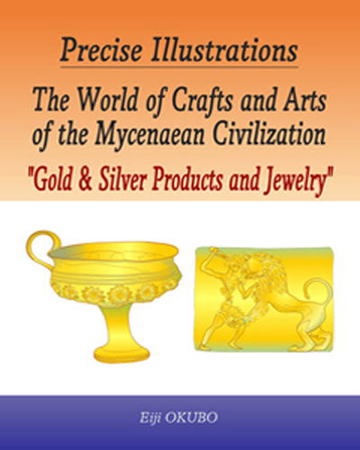 |
| subtitle: Data and explanations of excavated items language: English format: Paperback printing paper: Non-glossy high-quality paper printing ink: High-saturation premium ink size: 8in.x10in. (203mm x 254mm) 344 pages sales: Amazon Network / Amazon.com / Amazon.co.uk |
| Sumary: This book is 8in. x 10in. (203mm x 254mm) version, 340 pages, a “Precision Illustrations & Data Book” of excavated items from the prehistoric Mycenaean Civilization ruins on mainland Greece. This book is picked up 180 items of outstanding Mycenaean Gold & Silver Products and Jewelry excavated from important ruins of the Mycenaean Civilization in the Argolis, Messenia, and Laconia regions, including the Mycenae Palace and surroundings ruins, which were the center of the Mycenaean Civilization. In this book, more than 90% of the excavated items explained are depicted in Precise Illustrations, and the rest are shown in Photographs. This book will invite you to the “World of Crafts and Arts” of the Mycenaean Civilization through carefully selected important works from among the excavated items on display at the National Archaeological Museum of Athens and other archaeological museums throughout the Peloponnese. Contents: I What is the Mycenaean Civilization? II Gold Products / Cup III Gold Products / Signet Ring IV Gold Products / Death Mask, Breast-plate, Diadem V Gold Products / Necklace, Earrings, Hairpin VI Gold Products / Accessories, Sheet-processed products VII Silver Products VIII Semi-precious stones, Glass paste, Bronze Jewelry Products |
| Sample Page:(excerpt) ---------- Eye-popping jewelry goods excavated from in the Mycenaean Palace and the surrounding ruins of the Mycenaean civilization, especially gold jewelry items have been found those who owned them to have lived in the palace, judging from the preciousness of the material, the style, and motifs expressed in the works. It can be concluded that they, owners of gold jewelry, were extremely noble people such as members of the royal family, their relatives, and of the nobility class. In addition, if it limits to the excavated items of high-quality jewelry, the number of unearthed articles is slightly less from the ruins of palace buildings or mansions, but most of them have come from the excavation of tombs inside and near the Mycenae Palace, where royal families and nobles were buried. 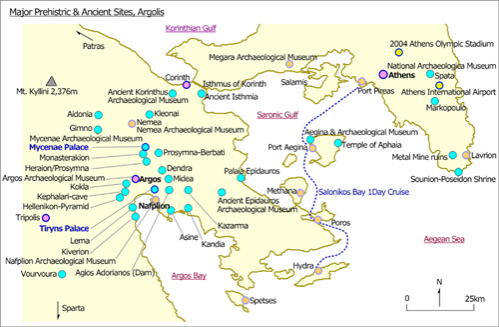 Major Sites of Prehistoric to Ancient Ages Local: Peloponnese - Argolis and Attica Drawing: Eiji OKUBO Among the gold products associated with the Mycenae Palace, remarkable features can be seen in the Gold Cups, which were excavated from Grave Circle A in the palace area and Grave Circle B to the west of it. Cups come in a variety of shapes, and the decorations are undecorated, perhaps which giving priority to the luster of gold with just a handle, and pinpoint decorations with traditional noble motifs such as rosette and spiral line patterns, or animal figures. Many cups are decorated on the sides with embossed depictions of bulls, leopards, and marine creatures such as dolphins, which were influenced by the naturalistic Minoan civilization in Crete. In addition, in terms of handles of the gold cup, a simple loop-curving ring-handle that is unique to the Mycenaean civilization, and Vaphio style handles were particularly used. As is also common with silver cups, some gold cups with elaborate granulation technique on the rim/mouth, have also been found. II-01 Gold Goblet 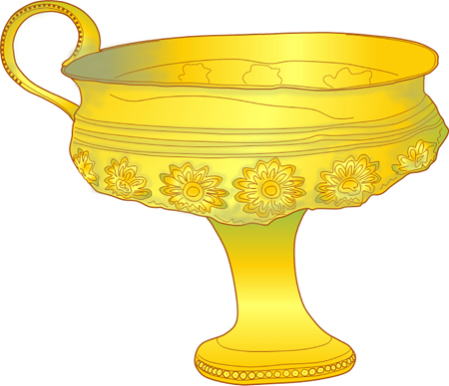 Site: Shaft Grave IV, GCA, Mycenae Palace Shape & Decoration: Gold Goblet with ring-handle rosettes in repoussé, granulation technique Era: LHI, ca. 1550 Museum: NAM, inv. No. 351 Local: Argolis, Peloponnese / 11km north-northwest from Argos city 90km west-southwest from Athen Drawing: Eiji OKUBO II-02 Gold Cup 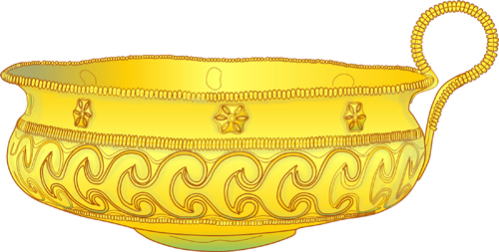 Site: Chamber Tomb 10, Dendra Shape & Decoration: Gold Cup, ivy & rosette patterns, granulation technique Era: LHIIIA1, 1400-1375 BC Museum: NAM, inv. No. 8743 mouth diameter D130mm, H50mm excluding handle Local: Argolis, Peloponnese / 7km north-northeast from Tiryns Palace Drawing: Eiji OKUBO GPS: 37°39’24’’N 22°49’32’’E / ALT 60m II-03 Vaphio style Gold Cup (1) 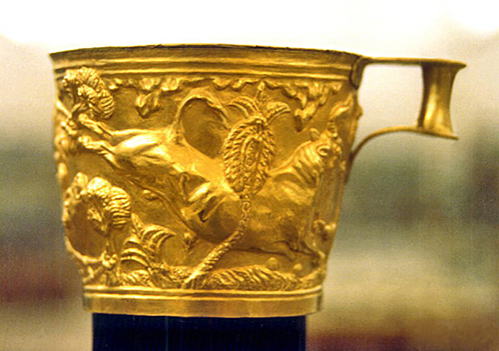 Site: Royal Tholos Tomb, Vaphio Shape & Decoration: Gold Cup in Vaphio style rampaging bulls & young man trying to catch in repoussé Era: LHIIA, 1500-1450 BC Museum: NAM, inv. No. 1758 / mouth diameter D108mm Local: Laconia, Peloponnese Photo: 1982 II-04 Vaphio style Gold Cup (2) 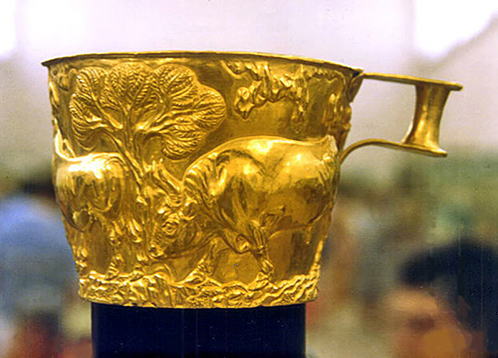 Site: Royal Tholos Tomb, Vaphio Shape & Decoration: Gold Cup in Vaphio style quiet bulls that have been subdued in repoussé Era: LHIIA, 1500-1450 BC Museum: NAM, inv. No. 1759 / mouth diameter D108mm Local: Laconia, Peloponnese Photo: 1982 Among researchers, this gold cup has become a model for prehistoric metal vessels and pottery styles, and is called the “Vaphio style Cup” due to its exquisite design and appearance. Related: Royal Tholos Tomb, Vaphio 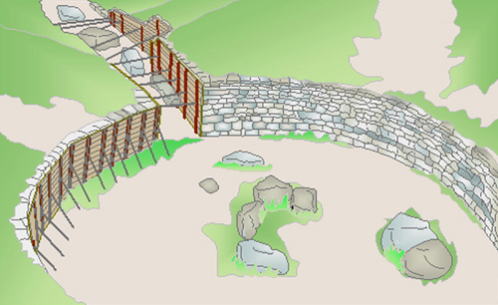 Site: Royal Tholos Tomb, Vaphio (as of 1982) Situation: Mycenaean Tholos Tomb inner diameter 10m, remaining wall height 1.6m Era: LHIIA, 1500-1450 BC Local: Laconia, Peloponnese / 7km south-southeast from Sparti city Drawing: Eiji OKUBO GPS: 37°01’13’’N 22°28’04’’E / ALT 195m II-05 Gold Stemmed Cup 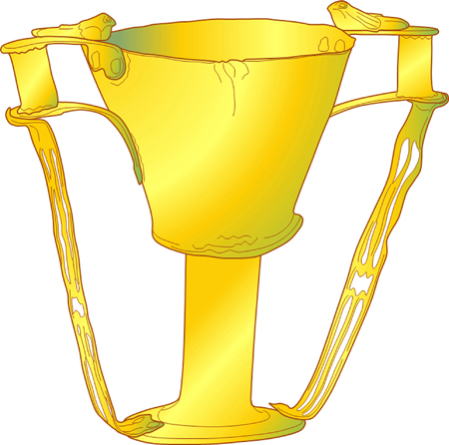 Site: Shaft Grave IV, GCA, Mycenae Palace Shape & Decoration: Gold Stemmed Cup in Vaphio Style doves on the rim so-called the “Nestor’s Cup” and “Dove Cup” Era: LHI, ca. 1550 BC Museum: NAM, inv. No. 412 / handle max. width 145mm Local: Argolis, Peloponnese Drawing: Eiji OKUBO III-01 Gold Signet Ring, “Golden Treasure of Acropolis” In particular, on gold signet rings, the carvings of goddesses, shrines, and sanctuaries, which can be said to be the inheritance or imitation of expressive motifs from the Minoan civilization, are remarkable and one or more curved sacred trees always grow there. Out of faith that blessings will be given that if they touch the branches and leaves of shrines and sanctuaries, not only the goddess but also Mycenaean youths and noble women with their hands reaching out to the branches and leaves were carved on them. In addition, the motif of the gold signet ring emphatically engraved with divine elements such as the goddess is called “Epiphany expression.” In some of gold signet rings, there are motif works that depict one or more goddesses watching over some kind of ceremony or sacred scene, or that goddesses wear luxurious and distinctive thick skirts originating from the Minoan civilization and flowers are scattered around them. We understand, in the divine motif expression of the gold rings, that noble people of Mycenae favored the goddess as well as the sacred animals griffin and sphinx. In addition, there are multiple scenes of lions which were symbols of the strong, and breastfeeding of familiar animals such as goats and cows. A fierce battle scene that speaks for the “militant Mycenaeans,” and dynamic scenes of hunting in cooperation with the pet dog, which are also common in frescoes, are characteristic motifs of gold signet rings of the Mycenaean civilization. 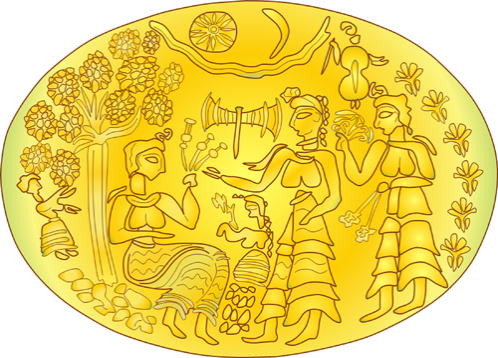 Site: House of the Great Ramp, Citadel, Mycenae Palace Shape & Decoration: Gold Signet Ring, “Golden Treasure of Acropolis Mycenae” Epiphany: six goddesses, double axe, shrine with sacred tree, Sun and crescent moon, flowers Era: LHIIA, 1500-1450 BC Museum: NAM, inv. No. 992 / L34mm, W25mm Local: Argolis, Peloponnese Drawing: Eiji OKUBO III-02 Gold Signet Ring 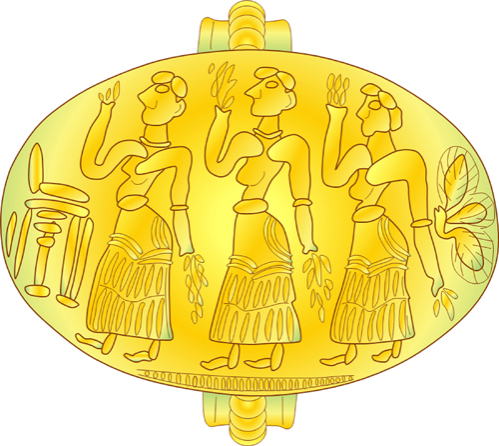 Site: Chamber Tomb 55, Lower Town, Mycenae Shape & Decoration: Gold Signet Ring, arm (hoop)=granulation technique Epiphany: three goddesses or women with flowers, shrine and scared tree Era: LHII-LHIIIA1, 1500-1375 BC Museum: NAM, inv. No. 2853 / L25mm Local: Argolis, Peloponnese Drawing: Eiji OKUBO III-12 Gold Signet Ring, “Treasure of Aidonia” 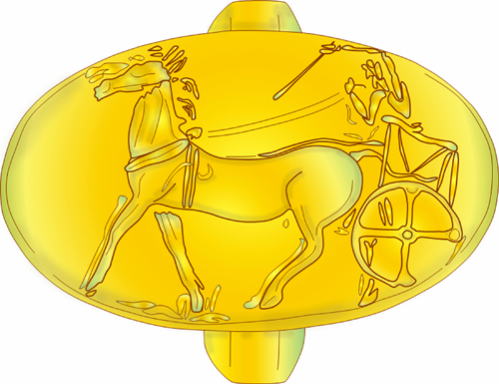 Site: Chamber Tomb 7, Aidonia, near Nemea Shape & Decoration: Gold Signet Ring, “Treasure of Aidonia,” two-wheeled chariot and a man Era: LHI-LHII, ca.1500 BC Museum: NEAM, inv. No. 1005 / L33.5mm Local: Corinthia, Peloponnese / 20 km northwest of Mycenae Palace Drawing: Eiji OKUBO Related: Mycenaean Stone Seal, “Two-wheeled chariot” 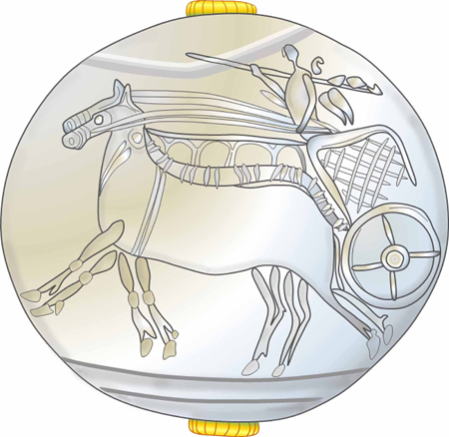 Site: Royal Tholos Tomb, Vaphio Shape & Decoration: Gold decorated Agate Seal two horses pulling two-wheeled chariot, two Mycenaean soldiers with spears Era: LHIIA, 1500-1450 BC Museum: NAM, inv. No. 1770 / L31mm Local: Laconia, Peloponnese Drawing: Eiji OKUBO III-14 Gold Seal, cushion shape 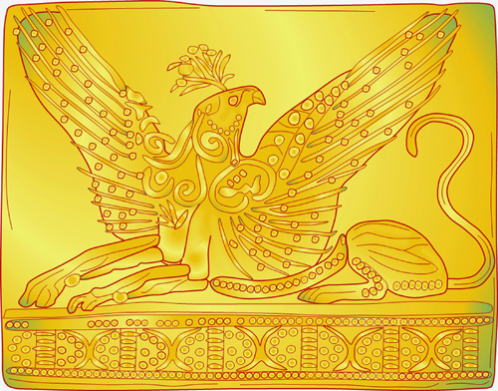 Site: Royal Tholos Tomb IV, Nestor’s Palace Shape & Decoration: Gold Seal, cushion shape, a griffin spreading wings, triglyph pattern back side=diamond (mesh) pattern Era: MHIII-LHIIA, 1650-1450 BC Museum: NAM, inv. No. 7986 / L27mm, W21mm, T6mm Local: Messenia, Peloponnese 13km north from Pylos port / 35km west from Kalamata city Drawing: Eiji OKUBO IV-01 Gold Death Mask, “Gold mask of Agamemnon”  Site: Shaft Grave V, GCA, Mycenae Palace Shape & Decoration: Gold death mask, in repoussé Excavator J.H. Schliemann's conjecture: “Gold mask of Agamemnon,” 13th century BC scholar's judgment: Death-mask of a "King" over 300 years older than King Agamemnon Era: LHI, ca. 1550 BC Museum: NAM, inv. No. 624 / H250mm, weight 168.5g Local: Argolis, Peloponnese Photo: 1987 IV-06 Electrum Death Mask  Site: Shaft Grave Γ, GCB, Mycenae Shape & Decoration: Electrum alloy Death mask, made by gold & silver alloy, in repoussé a burial good of the pioneering of "mask-covered burial" in the Early Mycenaean period Era: MHIII, 1625-1550 BC Museum: NAM, inv. No. 8709 / H240mm Local: Argolis, Peloponnese Drawing: Eiji OKUBO IV-13 Gold Diadem (full size) 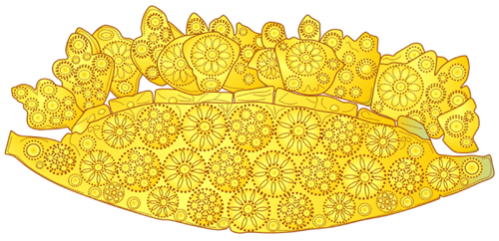 Site: Shaft Grave III, GCA, Mycenae Palace Shape & Decoration: Full size Gold luxurious Diadem rosette, circle, stippling patterns in repoussé Era: LHI, 1550-1500 BC Museum: NAM, inv. No. 1 / L635mm Local: Argolis, Peloponnese Drawing: Eiji OKUBO V-07 Gold Necklace  Site: Shaft Grave O, GCB, Mycenae Shape & Decoration: Gold Necklace, twin spiral Era: MHIII, 1625-1500 BC Museum: NAM, inv. No. 8649 Local: Argolis, Peloponnese Drawing: Eiji OKUBO VI-15 Gold Ornaments, “Lion Cub” motif 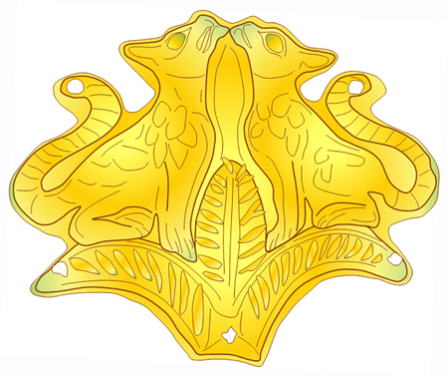 Site: Shaft Grave III, GCA, Mycenae Palace Shape & Decoration: Gold Ornaments, processed gold sheet two lion cubs facing each other on palm leaves in repoussé Era: LHI, 1550-1500 BC Museum: NAM, inv. No. 50 / L40mm, W34mm Local: Argolis, Peloponnese Drawing: Eiji OKUBO Related: Lion Gate, Mycenae Palace 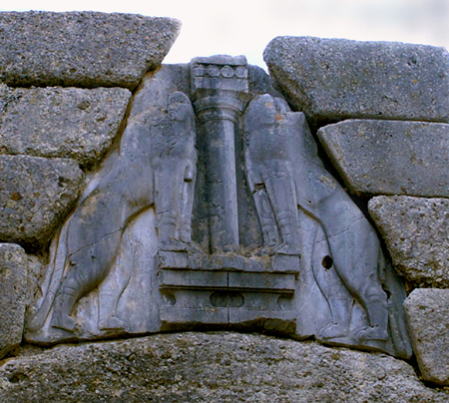 Site: Lion Gate, Mycenae Palace Situation: Limestone Relief, two Lions facing each other on the Lintel stone lion height approx. 90cm, original head=made of metal (bronze?) not currently exist Era: LHIIIB, ca. 1250 BC Local: Argolis, Peloponnese Photo: 1996 VII-01 Silver Goblet, Decoration of fine Inlay technique 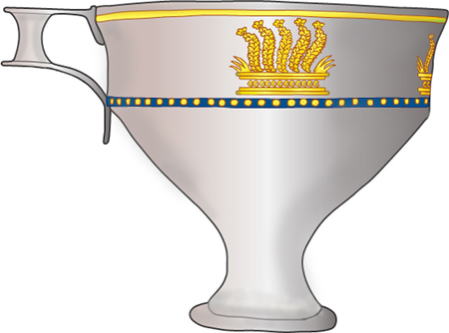 Site: Shaft Grave IV, GCA, Mycenae Palace Shape & Decoration: Silver Goblet, elaborate fine inlay technique fern leaves (or flower baskets), horizontal gold line, stippling gold on niello line Era: LHI, ca. 1550 BC Museum: NAM, No. 390 / H155mm Local: Argolis, Peloponnese Drawing: Eiji OKUBO VII-13 Silver funnel-shaped Rhyton, ”Siege Battle" 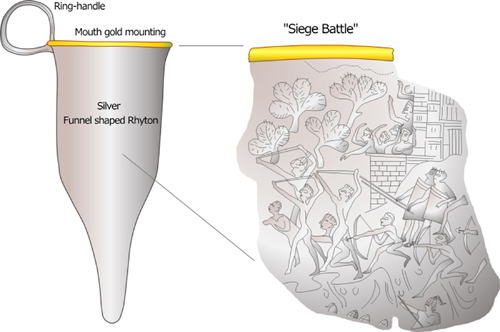 Site: Shaft Grave IV, GCA, Mycenae Palace Shape & Decoration: Silver funnel-shaped Rhyton, ring-handle, mouth gold mounting so-called ”Siege Battle" Era: LHI, ca. 1550 BC Museum: NAM, inv. No. 481 / body diameter D114mm Local: Argolis, Peloponnese Drawing: Eiji OKUBO VIII-02 Amber bead Necklace During the Mycenaean Era, as in many prehistoric civilizations, the original amber raw material was a rare material for ornaments, along with gold, silver, and lapis lazuli. The main production area of amber is from the Baltic Sea coast of the northern Europe and Poland, and it traveled 2,500 km in a straight line through complicated trade and exchange routes to reach the distant Peloponnese and Argolis regions over a mind-bogglingly long period of time. And then it was also transported to the Messenia region. 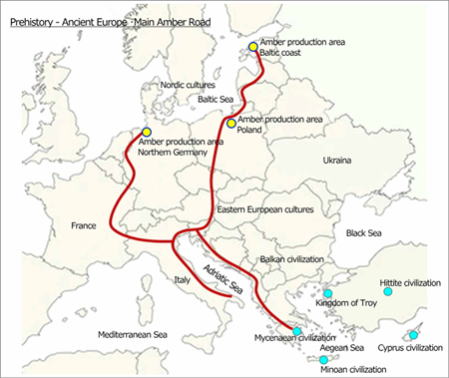 Prehistoric – Ancient Europe, Main “Amber Road” Amber main production area: Baltic coast and Poland Drawing: Eiji OKUBO 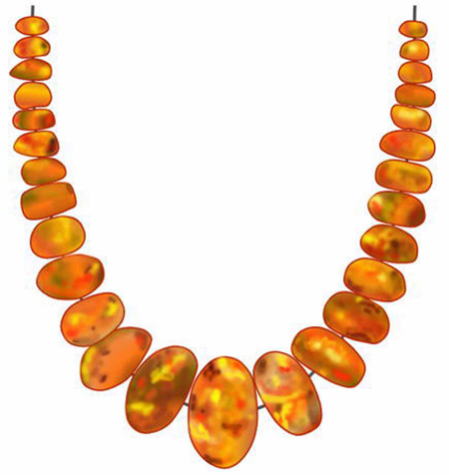 Site: Shaft Grave III, GCA, Mycenae Palace Shape & Decoration: Amber bead Necklace Era: LHI, 1550-1500 BC Museum: NAM Local: Argolis, Peloponnese Drawing: Eiji OKUBO VIII-31 Alabaster vase, gold decoration 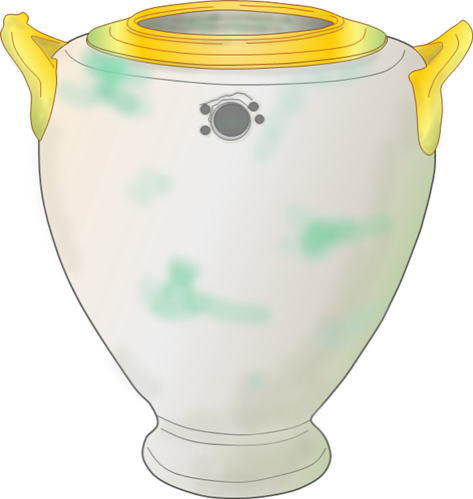 Site: Shaft Grave V, GCA, Mycenae Palace Shape & Decoration: Made in Egypt, Minoan style Alabaster vase, gold coving the mouth and handles Era: LHI, ca. 1550 BC Museum: NAM, inv. No. 829 / H170mm Local: Argolis, Peloponnese Drawing: Eiji OKUBO ---------- |